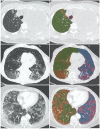Quantitative CT Extent of Lung Damage in COVID-19 Pneumonia Is an Independent Risk Factor for Inpatient Mortality in a Population of Cancer Patients: A Prospective Study
- PMID: 33014804
- PMCID: PMC7494966
- DOI: 10.3389/fonc.2020.01560
Quantitative CT Extent of Lung Damage in COVID-19 Pneumonia Is an Independent Risk Factor for Inpatient Mortality in a Population of Cancer Patients: A Prospective Study
Abstract
Background: CT lung extent has emerged as a potential risk factor of COVID-19 pneumonia severity with mainly semiquantitative assessment, and outcome was not assessed in the specific oncology setting. The main goal was to evaluate the prognostic role of quantitative assessment of the extent of lung damage for early mortality of patients with COVID-19 pneumonia in cancer patients. Methods: We prospectively included consecutive cancer patients with recent onset of COVID-19 pneumonia assessed by chest CT between March 15, 2020, and April 20, 2020, and followed until May 1, 2020. Demographic, clinical, laboratory test data and imaging findings were recorded. Quantitative chest CT assessment of COVID-19 pneumonia was based on the density distribution of lung lesions using a freely available software recently released (Myrian XP-Lung). The association between extent of lung damage and overall survival was studied by univariate and multivariate Cox analysis. The Uno C-index was used to assess the discriminatory value of the quantitative CT extent of lung damage. Results: Seventy cancer patients with chest CT evidence of COVID-19 were included. After a median follow-up of 25 days, 17 patients (24%) had died. The median quantitative chest CT extent of COVID-19 was 20% (IQR = 14-35, range = 3-59) for non-survivors vs. 10% (IQR = 6-15, range = 2-55) for survivors (p = 0.002). The extent of COVID-19 pneumonia was correlated with inpatient management (p = 0.003) and oxygen therapy requirements (p < 0.001). Independent factors associated with death were performance status (PS) ≥2 (HR = 3.9, 95% CI = [1.1-13.8] p = 0.04) and extent of COVID-19 pneumonia ≥30% (HR = 12.0, 95% CI = [2.2-64.4] p = 0.004). No differences were found regarding the histology of cancer, cancer stage, metastases sites, or type of oncologic treatment between the survivor and non-survivor groups. The cross-validated Uno C-index of the model including PS and extent of COVID-19 pneumonia was 0.83, 95% CI = [0.73-0.93]. Conclusions: The quantitative chest CT extent of COVID-19 pneumonia was a strong independent prognostic factor of early inpatient mortality in a population of cancer patients.
Keywords: COVID-19 pneumonia; cancer patients; prognostic performance; quantitative chest CT extent; risk factor for mortality.
Copyright © 2020 Ramtohul, Cabel, Paoletti, Chiche, Moreau, Noret, Vuagnat, Cherel, Tardivon, Cottu, Bidard and Servois.
Figures



References
-
- European Centre for Disease Prevention and Control Situation Update for the EU/EEA and the UK, as of 7 May 2020. (2020). Available online at: https://www.ecdc.europa.eu/en/cases-2019-ncov-eueea (accessed May 7, 2020).
LinkOut - more resources
Full Text Sources
Miscellaneous

